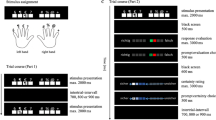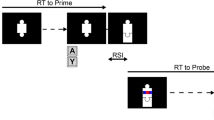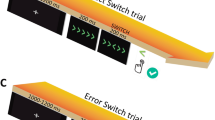Abstract
To study the effect of response-set size on action monitoring processes, the error-related negativity (Ne/ERN), the correct-related negativity (Nc/CRN), and behavioral indicators of action monitoring were compared across three groups of participants performing a two-choice, a four-choice, or an eight-choice version of the flanker task. After controlling for differential contribution of stimulus-related activity to response-locked averages resulting from large differences in response times across conditions, response-set size had strong effects on Ne/ERN and Nc/CRN. With increasing response-set size, the Ne/ERN amplitude decreased, but the Nc/CRN amplitude increased. Moreover, post-error behavioral adjustments were impaired with an increasing response-set size. These results suggest that action monitoring severely suffers when response-set size is increased. Implications of these findings for present theories of Ne/ERN and Nc/CRN are discussed.




Similar content being viewed by others
Notes
The data from the four-choice task were already published elsewhere (Maier et al. 2008). However, the data were re-analyzed in a way that was appropriate for all three response-set size conditions. Accordingly, trimming of the behavioral data, filtering, baseline correction, and quantification of ERP components have changed.
This baseline window was chosen, because it aligned the waveforms for correct and error responses with respect to the positive peaks preceding error-related brain activity. This best illustrates differences in Nc/CRN and Ne/ERN across conditions. Note, however, that the choice of baseline did not affect statistical analyses, because baseline-independent base-to-peak measures were used for component quantification.
We also analyzed the data using the mean voltage in a time window of −25 to 100 ms relative to the response for the Ne/ERN and −25 to 50 ms relative to the response for the Nc/CRN. This did not change the results qualitatively.
An alternative method for removing slow potentials from EEG data is to calculate so-called Surface Laplacians (see, Vidal et al. 2003).
Although the error rate was the same in our three conditions, the absolute number of errors differed because of different trial numbers. To examine whether this can account for our results, we re-analyzed the data using only the first 1,280 trials from each condition. This did not change the results. Accordingly, our findings are not related to the different absolute numbers of errors in the three conditions. Another possibility is that our results reflect the different number of trials used for computing the waveforms. To control for this effect, a bootstrapping technique was applied. The smallest number of error trials in a single participant was 38. Therefore, we recomputed waveforms for each participant by randomly drawing 38 trials from each condition (correct responses and errors), and repeated this for 1000 times. For each repetition, components were quantified, and component measures were averaged across repetitions. The results obtained in this way were the same as in the main analysis, suggesting that different trial numbers were not responsible for our results.
References
Alegria J, Bertelson P (1970) Time uncertainty, number of alternatives and particular signal–response pair as determinants of choice reaction time. Acta Psychol 33:36–44
Bernstein PS, Scheffers MK, Coles MG (1995) “Where did I go wrong?” A psychophysiological analysis of error detection. J Exp Psychol Hum Percept Perform 21:1312–1322
Carter CS, Braver TS, Barch DM, Botvinick M, Noll D, Cohen JD (1998) Anterior cingulate cortex, error detection, and the online monitoring of performance. Science 280:747–749
Coles MGH, Scheffers MK, Holroyd CB (2001) Why is there an ERN/Ne on correct trials? Response representations, stimulus-related components, and the theory of error-processing. Biol Psychol 56:173–189
Danielmeier C, Wessel JR, Steinhauser M, Ullsperger M (2009) Modulation of the error-related negativity by response conflict. Psychophysiology 46:1–11
Dehaene S, Posner MI, Tucker DM (1994) Localization of a neural system for error detection and compensation. Psychol Sci 5:303–305
Delorme A, Makeig S (2004) EEGLAB: an open source toolbox for analysis of single-trial EEG dynamics including independent component analysis. J Neurosci Methods 134:9–21
Delorme A, Sejnowski T, Makeig S (2007) Enhanced detection of artifacts in EEG data using higher-order statistics and independent component analysis. Neuroimage 34:1443–1449
Eriksen BA, Eriksen CW (1974) Effects of noise letters upon the identification of a target letter in a nonsearch task. Percept Psychophys 16:143–149
Falkenstein M, Hohnsbein J, Hoormann J, Blanke L (1990) Effects of errors in choice reaction tasks on the ERP under focused and divided attention. In: Brunia CHM, Gaillard AWK, Kok A (eds) Psychophysiological brain research, 1. University Press, Tilburg, pp 192–195
Falkenstein M, Hoormann J, Christ S, Hohnsbein J (2000) ERP components on reaction errors and their functional significance: a tutorial. Biol Psychol 51:87–107
Gehring WJ, Goss B, Coles MGH, Meyer DE, Donchin E (1993) A neural system for error detection and compensation. Psychol Sci 4:385–390
Gratton G, Coles MGH, Donchin E (1983) A new method for off-line removal of ocular artifact. Electroencephalogr Clin Neurophysiol 55:468–484
Hajcak G, Vidal F, Simons RF (2004) Difficulties with easy tasks: ERN/Ne and stimulus component overlap. In: Ullsperger M, Falkenstein M (eds) Errors, conflicts, the brain. Current opinions on performance monitoring, 1. Max Planck Institute of Cognitive Neuroscience, Leipzig, pp 204–211
Hajcak G, Moser JS, Yeung N, Simons RF (2005) On the ERN and the significance of errors. Psychophysiology 42:151–160
Hick WE (1952) On the rate of gain of information. Q J Exp Psychol 4:11–26
Holroyd CB, Coles MGH (2002) The neural basis of human error processing: reinforcement learning, dopamine, and the error-related negativity. Psychol Rev 109:679–709
Laming D (1979) Choice reaction performance following an error. Acta Psychol 43:199–224
Logan GD (1988) Toward an instance theory of automatization. Psychol Rev 95:492–527
Luu P, Tucker DM (2001) Regulating action: alternating activation of midline frontal and motor cortical networks. Clin Neurophysiol 112:1295–1306
Luu P, Flaisch T, Tucker DM (2000) Medial frontal cortex in action monitoring. J Neurosci 20:464–469
Maier M, Steinhauser M, Hübner R (2008) Is the error-related negativity amplitude related to error detectability? Evidence of effects from different error types. J Cogn Neurosci 20:2263–2273
Pailing PE, Segalowitz SJ (2004) The effects of uncertainty in error monitoring on associated ERPs. Brain Cogn 56:215–233
Rabbitt PM (1966) Errors and error correction in choice-response tasks. J Exp Psychol 71:264–272
Rabbitt PMA (1967) Time to detect errors as a function of factors affecting choice-response time. Acta Psychol 27:131–142
Rabbitt PMA (2002) Consciousness is slower than you think. Q J Exp Psychol Hum Exp Psychol 55:1081–1092
Scheffers MK, Coles MGH (2000) Performance monitoring in a confusing world: error-related brain activity, judgments of response accuracy and types of errors. J Exp Psychol Hum Percept Perform 26:141–151
Steinhauser M, Maier M, Hübner R (2008) Modeling behavioral measures of error detection in choice tasks: response monitoring versus conflict monitoring. J Exp Psychol Hum Percept Perform 34:158–176
Ullsperger M, von Cramon D (2001) Subprocesses of performance monitoring: a dissociation of error processing and response competition revealed by event-related fMRI and ERPs. Neuroimage 14:1387–1401
Usher M, Olami Z, McClelland JL (2002) Hick’s law in a stochastic race model with speed–accuracy tradeoff. J Math Psychol 46:704–715
Vidal F, Hasbroucq T, Grapperon J, Bonnet M (2000) Is the ‘error negativity’ specific to errors? Biol Psychol 51:109–128
Vidal F, Burle B, Bonnet M, Grapperon J, Hasbroucq T (2003) Error negativity on correct trials: a reexamination of available data. Biol Psychol 64:265–282
Yeung N, Botvinick MM, Cohen JD (2004) The neural basis of error detection: conflict monitoring and the error-related negativity. Psychol Rev 111:931–959
Author information
Authors and Affiliations
Corresponding author
Rights and permissions
About this article
Cite this article
Maier, M.E., Steinhauser, M. & Hübner, R. Effects of response-set size on error-related brain activity. Exp Brain Res 202, 571–581 (2010). https://doi.org/10.1007/s00221-010-2160-3
Received:
Accepted:
Published:
Issue Date:
DOI: https://doi.org/10.1007/s00221-010-2160-3




